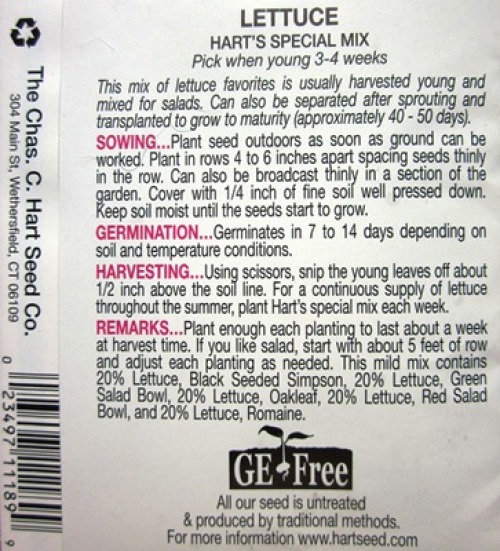
The Charles C. Hart Seed Company recently announced a new logo will be printed on all of its seed packets.
The new “GE Free” logo is meant to help gardeners see the company’s continuing commitment to distribute seed that is free of genetic engineering.
The Hart Seed company was founded in 1892 and remains one of the oldest seed companies in the country. This new logo represents another first for the company.
According to company sources, Hart Seed has been first with many new ideas in its long history. These ideas include being the first to provide accurate photo packets, first to package ‘Better Boy’ tomato seeds for home gardeners and first to print UPCs on the packets.
Now the company has added the GE Free logo that assures customers the seed in the packet is free of genetically engineered organisms.
Because gardeners may not know the difference between GE seed and GMO seed, plus the other kinds of seeds offered by seed companies, here’s a glossary to help with the seed sorting:
Glossary of Seed Terms
GE-Genetically Engineered seed describes the method of incorporating genes directly into an organism. These seeds are not found in nature, but they are genetically engineered in the laboratory. Some examples of genetically engineered crops include corn modified to protect itself from corn borer damage and herbicide-resistant soybeans and other crops. It’s unlikely that home gardeners will see any packets of GE seeds in garden centers or catalogs.
GMO-Genetically Modified Organisms are different from those genetically engineered. GMO is a broad term that refers to seeds produced through any type of genetic modification. This modification can be through modern genetic engineering or through traditional plant breeding. When plant breeders, working with conventional or organically produced varieties, select for certain desirable traits they are making the same kinds of selections that can happen in nature. This produces a type of hybrid. Examples include adding disease resistance to an open-pollinated variety or a hybrid cross between two cultivars. If you’ve ever enjoyed a seedless watermelon, you’ve tasted a genetically modified organism.
Heirloom-Heirloom seeds are typically defined as open-pollinated varieties that are the result of natural selection instead of controlled hybridizing. These are varieties that have been passed down over generations, but commercial seed producing companies now grow seeds from many heirlooms. Seeds saved from heirlooms will produce plants with the same traits as the parent plant. Some favorite heirlooms include ‘Brandywine’ tomatoes and ‘Kentucky Wonder’ beans.
Hybrid-Hybrid plants are often labeled F1 because they are the first generation hybrid. Modern hybrids are produced by cross-pollinating two distinct parents for their positive traits. Any F1 seeds saved and planted will not grow “true” like open-pollinated varieties. Examples of popular hybrids are ‘Celebrity’ and ‘Sungold’ tomatoes.
OP–Open-pollinated seed varieties result from being pollinated by insects, wind or other methods of natural pollination. Seeds saved from open-pollinated plants will grow the same plant as its parent plants, year after year.
Organic Seed-The term “Certified Organic” on a seed packet is a legal distinction. It means the growers comply with all the rules and regulations specified by the USDA’s National Organic Program. Organic seeds are grown without the use of synthetic fertilizers and pesticides. Genetic engineering is prohibited.
Treated Seed-Treated seeds are seeds coated with a product, usually a fungicide. Treated seeds provide a layer of protection against soilborne diseases and fungi and seed companies will specify if the seed is treated. Peas and corn are two examples of seeds that are often treated.


















Comments
Log in or create an account to post a comment.
Sign up Log in